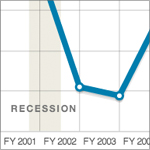As Revenue Returns, States Build Back Reserves
Note: These data have been updated. To see the most recent data and analysis, visit Fiscal 50
To see the most recent analysis for Fiscal 50, please visit our overview page.
Half of the states expected to have enough financial cushion to cover at least 20 days of operating expenses in fiscal 2013. While states are restoring the reserves and balances tapped during the Great Recession, the median number of days was still 21 short of its prerecession level in fiscal 2007.
For the first time in five years, no state in fiscal 2013 expected its combination of rainy day reserves and general fund balances to drop below zero as it balanced its budget. Another sign of improving state finances was that 13 states were on track to match or exceed the financial cushions they had before the Great Recession, measured in days of operating expenses.
While increasing reserves and balances are a sign of fiscal recovery, there is no single best practice for determining what share of operating costs states should have on hand to deal with unexpected downturns or expenses. Small states or those with a history of highly volatile revenue performance may require larger cushions.
Most Days of Operating Expenses in Reserve, FY 2013 |
|||
| Alaska | 775 days | ||
| Wyoming | 194 days | ||
| West Virginia | 116 days | ||
| North Dakota | 89 days | ||
| Iowa | 85 days | ||
|
Source: Pew analysis of data from the Fiscal Survey of States, published by the National Governors Association and the National Association of State Budget Officers |
|||
According to states’ estimates for fiscal 2013:
- Nearly two-thirds (32 states) expected to have more days’ worth of operating expenses in reserve than in fiscal 2009, when total state tax revenue and reserves simultaneously bottomed out.
- Alaska (775 days) and Wyoming (194 days) had the biggest reserves as a share of operating costs.
- The smallest reserves—totaling one day or less of operating costs—were in Arkansas, Connecticut, Illinois, and Maine.
From fiscal 2009 to fiscal 2012, Arizona, California, Kansas, Oregon, Pennsylvania, and Washington drained their reserves and ended with a negative fund balance in at least one year, requiring them to borrow or transfer cash to cover operating costs.
Even as state revenue recovers, budget surpluses do not automatically mean that reserves will be replenished. For example, California’s projected budget surplus for fiscal 2014 launched a debate over whether to spend or save the funds. Ultimately, legislators budgeted $1.1 billion for the rainy day fund and the rest for debt payments and education and health spending.
This measure does not take into account additional resources some states may have available to cushion downturns, such as balances outside of its general fund. So it may not reflect a state’s complete fiscal cushion. In addition, some states undertake considerable spending outside of the general fund, so comparisons across states should be made with caution.
Analysis by Robert Zahradnik and Aidan Russell







